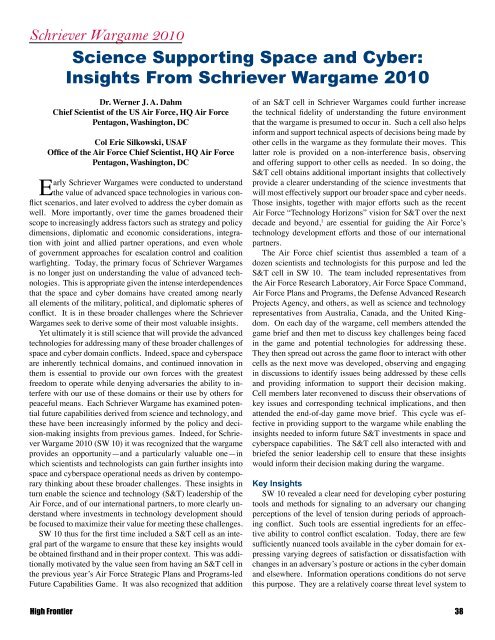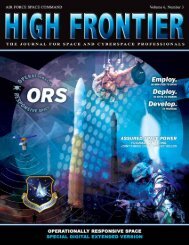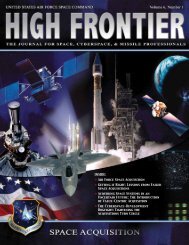Schriever Wargame 2010 - Air Force Space Command
Schriever Wargame 2010 - Air Force Space Command
Schriever Wargame 2010 - Air Force Space Command
- No tags were found...
Create successful ePaper yourself
Turn your PDF publications into a flip-book with our unique Google optimized e-Paper software.
<strong>Schriever</strong> <strong>Wargame</strong> <strong>2010</strong><br />
Science Supporting <strong>Space</strong> and Cyber:<br />
Insights From <strong>Schriever</strong> <strong>Wargame</strong> <strong>2010</strong><br />
Dr. Werner J. A. Dahm<br />
Chief Scientist of the US <strong>Air</strong> <strong>Force</strong>, HQ <strong>Air</strong> <strong>Force</strong><br />
Pentagon, Washington, DC<br />
Col Eric Silkowski, USAF<br />
Office of the <strong>Air</strong> <strong>Force</strong> Chief Scientist, HQ <strong>Air</strong> <strong>Force</strong><br />
Pentagon, Washington, DC<br />
Early <strong>Schriever</strong> <strong>Wargame</strong>s were conducted to understand<br />
the value of advanced space technologies in various conflict<br />
scenarios, and later evolved to address the cyber domain as<br />
well. More importantly, over time the games broadened their<br />
scope to increasingly address factors such as strategy and policy<br />
dimensions, diplomatic and economic considerations, integration<br />
with joint and allied partner operations, and even whole<br />
of government approaches for escalation control and coalition<br />
warfighting. Today, the primary focus of <strong>Schriever</strong> <strong>Wargame</strong>s<br />
is no longer just on understanding the value of advanced technologies.<br />
This is appropriate given the intense interdependences<br />
that the space and cyber domains have created among nearly<br />
all elements of the military, political, and diplomatic spheres of<br />
conflict. It is in these broader challenges where the <strong>Schriever</strong><br />
<strong>Wargame</strong>s seek to derive some of their most valuable insights.<br />
Yet ultimately it is still science that will provide the advanced<br />
technologies for addressing many of these broader challenges of<br />
space and cyber domain conflicts. Indeed, space and cyberspace<br />
are inherently technical domains, and continued innovation in<br />
them is essential to provide our own forces with the greatest<br />
freedom to operate while denying adversaries the ability to interfere<br />
with our use of these domains or their use by others for<br />
peaceful means. Each <strong>Schriever</strong> <strong>Wargame</strong> has examined potential<br />
future capabilities derived from science and technology, and<br />
these have been increasingly informed by the policy and decision-making<br />
insights from previous games. Indeed, for <strong>Schriever</strong><br />
<strong>Wargame</strong> <strong>2010</strong> (SW 10) it was recognized that the wargame<br />
provides an opportunity—and a particularly valuable one—in<br />
which scientists and technologists can gain further insights into<br />
space and cyberspace operational needs as driven by contemporary<br />
thinking about these broader challenges. These insights in<br />
turn enable the science and technology (S&T) leadership of the<br />
<strong>Air</strong> <strong>Force</strong>, and of our international partners, to more clearly understand<br />
where investments in technology development should<br />
be focused to maximize their value for meeting these challenges.<br />
SW 10 thus for the first time included a S&T cell as an integral<br />
part of the wargame to ensure that these key insights would<br />
be obtained firsthand and in their proper context. This was additionally<br />
motivated by the value seen from having an S&T cell in<br />
the previous year’s <strong>Air</strong> <strong>Force</strong> Strategic Plans and Programs-led<br />
Future Capabilities Game. It was also recognized that addition<br />
of an S&T cell in <strong>Schriever</strong> <strong>Wargame</strong>s could further increase<br />
the technical fidelity of understanding the future environment<br />
that the wargame is presumed to occur in. Such a cell also helps<br />
inform and support technical aspects of decisions being made by<br />
other cells in the wargame as they formulate their moves. This<br />
latter role is provided on a non-interference basis, observing<br />
and offering support to other cells as needed. In so doing, the<br />
S&T cell obtains additional important insights that collectively<br />
provide a clearer understanding of the science investments that<br />
will most effectively support our broader space and cyber needs.<br />
Those insights, together with major efforts such as the recent<br />
<strong>Air</strong> <strong>Force</strong> “Technology Horizons” vision for S&T over the next<br />
decade and beyond, 1 are essential for guiding the <strong>Air</strong> <strong>Force</strong>’s<br />
technology development efforts and those of our international<br />
partners.<br />
The <strong>Air</strong> <strong>Force</strong> chief scientist thus assembled a team of a<br />
dozen scientists and technologists for this purpose and led the<br />
S&T cell in SW 10. The team included representatives from<br />
the <strong>Air</strong> <strong>Force</strong> Research Laboratory, <strong>Air</strong> <strong>Force</strong> <strong>Space</strong> <strong>Command</strong>,<br />
<strong>Air</strong> <strong>Force</strong> Plans and Programs, the Defense Advanced Research<br />
Projects Agency, and others, as well as science and technology<br />
representatives from Australia, Canada, and the United Kingdom.<br />
On each day of the wargame, cell members attended the<br />
game brief and then met to discuss key challenges being faced<br />
in the game and potential technologies for addressing these.<br />
They then spread out across the game floor to interact with other<br />
cells as the next move was developed, observing and engaging<br />
in discussions to identify issues being addressed by these cells<br />
and providing information to support their decision making.<br />
Cell members later reconvened to discuss their observations of<br />
key issues and corresponding technical implications, and then<br />
attended the end-of-day game move brief. This cycle was effective<br />
in providing support to the wargame while enabling the<br />
insights needed to inform future S&T investments in space and<br />
cyberspace capabilities. The S&T cell also interacted with and<br />
briefed the senior leadership cell to ensure that these insights<br />
would inform their decision making during the wargame.<br />
Key Insights<br />
SW 10 revealed a clear need for developing cyber posturing<br />
tools and methods for signaling to an adversary our changing<br />
perceptions of the level of tension during periods of approaching<br />
conflict. Such tools are essential ingredients for an effective<br />
ability to control conflict escalation. Today, there are few<br />
sufficiently nuanced tools available in the cyber domain for expressing<br />
varying degrees of satisfaction or dissatisfaction with<br />
changes in an adversary’s posture or actions in the cyber domain<br />
and elsewhere. Information operations conditions do not serve<br />
this purpose. They are a relatively coarse threat level system to<br />
High Frontier 38











